Several years ago, the following piece of old ecclesiastical goldwork embroidery was handed over to me. It is beyond use as far as an ecclesiastical piece is concerned, and rather than leaving it in some storage cupboard somewhere, the general consensus was that I could take it apart, save some hard-to-find materials on it, and learn something in the process.
Overall, though the piece is attractive in parts and might look ok from afar, it is not really a well-designed ecclesiastical piece. Still, I like certain individual elements of the design.
This is an excellent piece for learning. Although I would never consider taking certain embroideries apart, this one is perfect for “deconstructing” in order to learn from it. Since I’m photographing the process and discoveries, I thought I would share them with you.
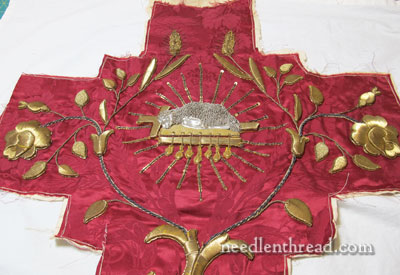
Don’t be too deceived by the photos. In the photos, the gold tends to look exceptionally bright and in good repair. Up close, the gold is tarnished and in bad repair. The ground fabric held up pretty well, but that’s essentially because of the way the piece was constructed, which we’ll look at in a minute.
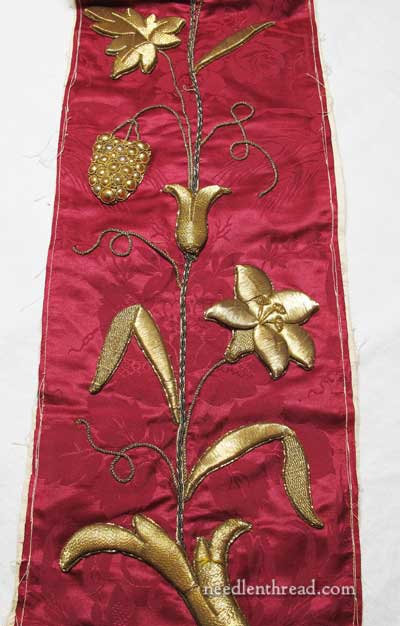
When laid out, the piece is in the shape of a cross. It comes from the back of a chasuble, which is a vestment worn by a priest during Mass. Directly above is the lower column of the cross, with the first picture above being the top part of the cross.
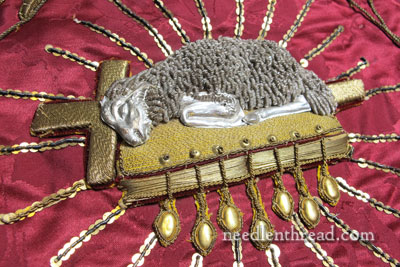
The design features the Agnus Dei symbol in the center of the cross. The lamb is resting on a cross on top of a book with seven seals, a Biblical symbol from the book of the Apocalypse (or Revelation), Chapter 5.
Around the Agnus Dei radiates lines made of spangles, sewn on with gold purl.
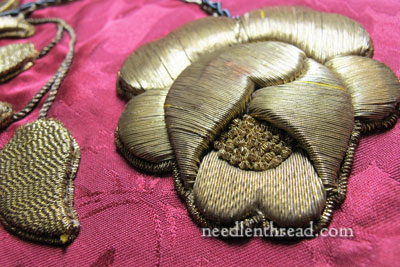
On the vine that surrounds the Angus Dei on the top part of the cross, we find some smaller leaves and some very large, heavy, high-relief roses.
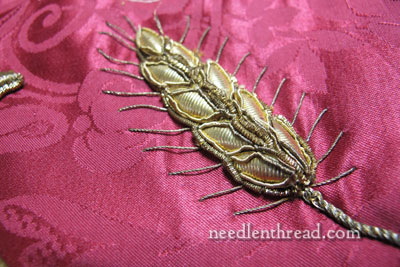
There are also a few heads of wheat on the vine.
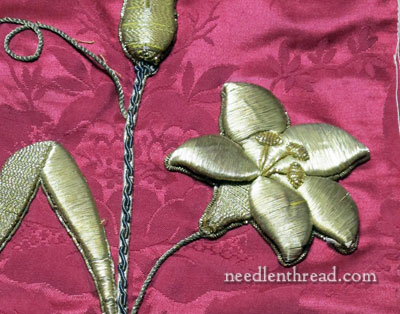
On the lower column of the cross, there’s a lily with few long, slender, folded lily leaves. There’s also a very large grape leaf towards the top of the column, with an acanthus-like leaf at the very top of the column, and …
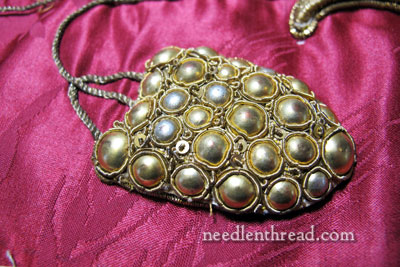
… somewhere in the middle of the column, hanging off to the left, there’s a small, awkward-looking, stiff, grape-like bunch that is considerably disproportioned, when viewing the whole design.
It’s an odd conglomeration of elements in one piece of embroidery for one vestment. Symbolically, the Agnus Dei and lilies go well together (think Easter). The Agnus Dei and wheat and grapes go together. But all of them, and roses, in one piece tends to crowd up the symbolism a bit.
In addition to this rather haphazard collection of elements, the embroidered pieces taken individually are very heavy. They are joined by a very light and scraggly vine-like line. The lightness of the joining vine makes each embroidered element seem even heavier.
The embroidery, taken by itself, is well done. But overall, the design lacks a certain balance, coherence, and unity.
Embroidered Slips
The heaviness of the individual pieces would normally have worn out that red silk (the ground fabric) a little more. So why is the ground fabric in such good shape?
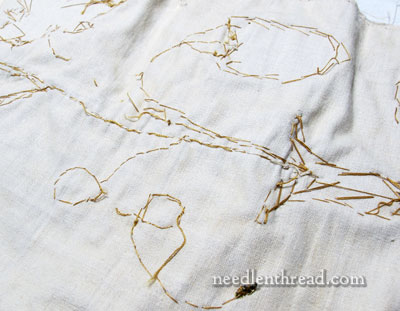
If you look at the back of the whole piece, the answer is evident. The embroidery was not done directly on the red silk, which is backed by linen. The skinny little vine that runs through the piece is couched directly on the ground fabric, and the rest of the elements are embroidered slips.
What’s a slip? A slip is a piece of embroidery done on another piece of fabric, cut out from that fabric, and then tacked onto another ground fabric. At the top of the photo directly above, you can see a shield-shaped sewn area. That’s where the grapes are sewn onto the fabric.
So there’s no real embroidery going into the ground fabric at all, except for an occasional plunged thread from the vine. All those heavy elements on this piece were actually embroidered on separate fabric first, cut out, and applied to ground fabric for the vestment.
That’s the piece overall. Next, I’ll tell you why I have no qualms about taking the piece apart, and we’ll start deconstructing the individual elements to see what they are and how they were made.
Any questions? Comments? Suggestions? Constructive Criticism? Feel free to have your say below!







Dear Mary, I LOVE your articles on ecclesiastic embroidery!I have loved embroidery my whole life. My brother is a Catholic priest and I have often longed to make vestments for him. The church vestments are unbelievably expensive, and my brother, being rather humble, does not own any that are elaborately embroidered. I just never knew where to begin. But now, having found your site and its wealth of information I at least have a jumping off point! So thank you for sharing your knowledge and enthusiasm. Perhaps I’ll be able to make him a vestment after all!
Hi, Annie! I hope you do make him some embroidered vestments! I’m glad you enjoy the information and that it is useful for you! ~MC
Annie,
Although I am no expert, I have made a couple of vestments and studied historical vestiture while I was at seminary. The best place to start would be with your brother. He would know which size fits him, which fabrics he prefers to wear and if there are specialized blessings for the fabrics or for the finished product that need to be done before their use. I’m not Catholic, but I know R.J. Toomey is a great catalog to begin looking for fabrics for Catholic vestments.
Almost all denominations have some sort of vestment or altar supply catalog that would sell yardage for you to make your own linens as well as specialized embroidery pieces for applique. Patterns for embroidery are harder than the fabrics. If you wonder where to get a catalog, check with your church office or sacristy leaders. I know Gaspard’s will sell yardage as well.
Hi Mary:
I am just wondering how old the vestment is. The ground fabric and lining does look very new. Do you know when and where it was made?
Thanx
Regards
Ann, Canada
Hi, Ann – the ground fabric looks newer or fresher in the photos, because of the vivid color. It’s actually pretty dingy and definitely not new, but still whole, with no major damage. No provenance on the piece, I’m afraid…
Hi Mary!
A very quick guess, before I look at any other comments or see more information from your ‘deconstruction’ process . . . my bet is that this piece was made up from elements of another (or other) ecclesiastical piece(s). Possibly in a situation where other ground fabrics had not fared very well, and someone was being frugal and wanted to get more use from the gold embroidery? Or possibly the major elements were purchased and then assembled into this chasuble? Again, just a guess . . .
I can’t wait to see what you discover as you go through this process. I love your detective work!
Sharlotte
Yes, that’s my thought, too, Sharlotte – not purchased, necessarily, but more likely salvaged from a much older piece (or pieces).
What an opportunity – it’s sort of like opening a Christmas Present – getting to see what’s inside? Can’t wait.
🙂 Yes, it is kind of like opening a Christmas present – but it takes just a wee bit more work!
Very interesting! The red background is patterned.
Any idea how old this is? I am thinking the gold slips are from very much older pieces and were recycled onto this piece. That could explain the rather haphazard design. I look forward to the deconstruction.
No idea on the age. I also suspect the goldwork is older than the red ground fabric. More on that coming up…
As someone who is just starting to get my hands around ecclesiastical embroidery, and hopes to dedicate my time to it, I can’t wait for you to start dissecting this piece, especially the larger flower designs. They are intriguing.
Thank you for your blogs
Kate
How, if at all, is a slip different than a hand embroidered applique put on a ground fabric?
It’s not. A “slip” is a piece of hand embroidery (often just a single design element) appliqued to another piece of fabric.
Mary, thanks so much for this excellent article! I’m certainly looking forward to learning more about this piece.
Hi Mary:
Thank you for sharing your experience about the deconstruction of the ecclesiastic embroidered piece. I look forward to more.
Your entire website is a great place to learn and to be inspired. Since I have added my email address, I think I have surfed just about everyday on the site. I really appreciate your dedication!
Thanks, Connie! 🙂
Somebody put a lot of time and effort into the piece. I would think the heaviness of the individual pieces would have pulled on the silk even tho they weren’t actually done on the silk.
I am going to enjoy your adventure.
Hi. The sheep’s wool is amazing! Are those real metal bullions?
Yes, it is. It’s bright check purl or “frieze brilliant”….
At first I was appalled that you were going to take this apart, even wondered if you would somehow restore it when finished. Now I see it’s not worth it. I’m anxious to see how the really thick pieces were padded. They’re so blocky looking it makes me think of those slabs of foam at the craft store. LOL I must say that I am rather fond of the lamb though. Are those all bullions making up the fleece? Hurry, hurry – inquiring minds want to know.
I agree with Irene M. The lamb looks so sweet. The fleece looks really soft! It’ll be interesting to see what is hidden inside of those slips. I’ve purchased some materials for goldwork and several books on the topic. The Internet is a goldmine!
I’m going to design a secular piece of goldwork in a modern style. However, I’m interested in ecclesiastical textiles and vestments and want to learn how to do goldwork in a proper way. Thank you for your interesting blog!
Mary,
The goldwork looks beautiful! Thanks for sharing the detailed pictures with us.
Just a thought–Perhaps since the goldwork is worked on another fabric and the pieces don’t seem to all relate to one another, they are recycled from older vestments and the current designer decided to use all the elements so as not to waste them??? Maybe she was being as creative as she could be with what she had to work with??? We’ll never know.
Dear Mary
How exciting what a piece to deconstruct and I wonder what you will find underneath, I can’t wait to see what you will discover from the garment. I love the sheep and the book how was the sheep and book made. Look forward with anticipation to your deconstruction.
Regards Anita Simmance
The gold work is very common and typical of India. I remember that when the gold work [especially on saris] looked a little dull, there were experts who polished it and it looked like new!If you have more pieces like these, you may want to look into this.
mangala
I wondered whether it had been done by more than one person which was why the elements were heavy than the straggly vine and why it seems such an assortment of elements.
Mary, I’m a relatively new subscriber and want to tell you how much I love and look forward to seeing “Needle and Thread” in my inbox. I have purchased some of the tool and books that you review and all are excellent.
I love the idea of deconstructing this piece and seeing where the elements take you and I look forward to watching that journey evolve.
Lauren Dudley
Glad you’re enjoying our explorations, Lauren! 🙂
I’ve never done this kind of embroidery but was always drawn to the beauty and symbolism of ecclesiastical pieces and the devotion of the stitchers. This will be a fascinating series!
Dear Mary, I am working on fixing up our Priest’s goldwork vestment, which has this exact Angus Dei emblem on it as the one you are deconstructing. I am curious to where I can obtain the metal pieces of the seven seals as well as the pieces of wheat. Also, I am confirming that the “wool” of the lamb is the bright check bullion. I am so thrilled that you are sharing your knowledge of the beautiful world of embroidery.
Thank you so much,
Angela
Hi, Angela – This is somewhat funny – most folks want to know where to get the legs and head of the lamb in the silver. Are you embroidering the legs and head, or do you already have a set? As for the metal pieces on the seals and wheat, I’ve not found a source for goldwork metal pieces anywhere, though I have looked high and low. Same with the grapes – I’d love to find a source for those, too. But I just don’t think they’re made anymore. ~MC
Hi Mary,
I have the legs and head of the lamb, they are in mint condition. The emblem is pretty much intact like the one you have. The wool has rubbed off on some of the high relief areas over the hind quarter of the lamb and I would like to give him some more. What’s even better, is I have a second emblem that I bought on ebay because I have been asked to make a gold altar frontal to match, but this lamb also needs a little wool. I’m intimidated by the amount of work that an altar frontal is going to involve, but also excited. What a bummer that they don’t make those metal pieces anymore. I guess I’ll have to get creative!
Angela
Angela,
If you feel adventurous I believe you may be able to construct the pieces from sheet metal using a dapping block and a metalworking technique called ‘sinking’.
http://en.wikipedia.org/wiki/Sinking_(metalworking)
The materials are available in several online beading and jewelry supply shops and from what I’ve heard, the technique is not overly difficult to learn. The wheat pieces may be a somewhat different beast though.
Another option would be to see if there is a medieval recreation society in your area. I’m willing to bet there’s someone there that could make some of these pieces (I have friends in a group and they have proven to be priceless founts of knowledge and suppliers of the impossible).
I hope this gives some help, or maybe even an idea of where to find help.
Amanda
Thanks, Amanda! Very good ideas!!
Mary!! Do you HAVE to take it apart? is there no where it can be used?
I hate to see old church embroideries dismantled. It is a great piece of history!!
I love this so much, awesome, I’m wondering is it normal to get tired doing the same piece. Would it be better to take a break and sew on something else. Or stick to your guns and finish what you start? Just want to say thank you so much for every thing you do to help us
I get bored working one project at a time. I usually have three or four going, varying crafts and all. At the moment I have two embroidery projects, one beading project, and one crochet project in the works. I rotate them out when I get tired of looking at the one I’m currently working on.
But I know plenty of people who don’t like the distractions – they prefer to plug away at something until its finished.
Different strokes and all that, y’know? If you’re getting bored with your project, there’s nothing wrong with putting it away and working on something else to break the monotony, if that’s what you want. This may not be as effective if you’re on a deadline, but if it’s a personal project just for fun, it’s fine, in my opinion. After all, if it’s boring you, it isn’t fun anymore and then what’s the point?
I’m wondering if someone at the Royal School of Needlework, http://www.royal-needlework.org.uk , might have connections to purchasing some of goldwork metal pieces? One part of the work they do is restoring fiber art, some of which is very delicate. Just a thought.
Oh, good! You’ve started the deconstruct project already. I love these. It’s a discovery and a window into the art. I am anxious to see what they used to get that high relief on the roses.
Thanks for taking time to do this, Mary
Mary – We have a Jewish Museum in Tulsa and I have helped work to stabilize and repair a few pieces that we have. I t is fascinating to see an entire piece taken apart. I amazes me to see the amount of work that has gone into these pieces. Thank you for all your work to continue the teaching.
Hi, Mary, I was surprised that this was used on a chasuble, it’s so bulky and bumpy. The flowers are very nice, but flowers are easier than some other elements. I love that rose. In Austria at a stift up in the Alps I saw a number of sets of vestments with some of the saints embroidered in high, sculpted relief just like that. I love the flowers but the faces are amazing. Thanks for taking this apart for us. Can’t wait to see that. Wish we could get that gold thread. I’m using 0.8 gold for the piece I’m making and it looks good but not as smooth as these.
Hi, Anne – yes, it’s the cross on the back of a “Roman” chasuble, which is quite different from the flowy “Gothic” style vestments used today. (Gothic being a bit of a misnomer in my opinion.) The “Roman” vestment is usually fairly stiff and supports heavier work. I know what you mean about the threads! I’m experimenting with a few different ones, but haven’t come up with the perfect solution to achieve this type of smooth coverage. Well, we’ll see….! ~MC
This is interesting ! I will follow each posting. Thank You
Mary another great newsletter.
I am not religious but I do like religious garments for their design and downright beauty. My favourite piece of your item is the lamb.
No other reason than it is very life like and sweet. I wonder if the face and leg is leather?
Leather that has been pressed into a shape. Same with the grape piece. Which is very symbolic to me as the bunch of grapes reminds me of a goblet top.
The whole item is symbolic of course.
The roses were not continued down the garment?
There is a lily, I find it quite lovely and that reminds me of the Song of Solomon, consider the lilies of the field.
Looking at the all over you can see that it was off the silk ground.
I have to say that the pieces individually are really lovely. I look forward to seeing it dismantled.
A word to ANNIE and making something for her brother.
Try a stole. It can be made for everday or a special occasion. I made one years ago for a catholic priest who was a friend of my husband and I. He was located in a very remote area of New Guinea. So I made a very bright and colourful stole and it went down a treat with the congregation. A stole is a good item to start with and personal.
Happiness to all
MM
Hi, Martha – the lamb’s legs and head are metal. I’ll show them close up a little later on! I second your suggestion to start with a stole, since one has to be made, anyway, with a set of vestments. ~MC
Really interesting. I like the use of slips as a means of preservation of the background fabric and have just completed a metal thread piece of embroidery using a slip for a large section of it.
Wow-Mary- I can’t wait to watch this project as it unfolds -! Amazing information and pictures so far. Thanks.
PS- Are you sure the damask is silk? From the picture it looks cotton, or cotton/poly blend…
It’s silk. I did a burn test.
Mary,
What do you mean by “the burn test” that let you know that the fabric was silk? And, wow, thanks for sharing this wonderful adventure.
Bonnie
Hi, Bonnie – when you burn silk, it will create a soft ball of ash and will smell like burning hair. Cotton produces soft ash that smells like burning paper. Anything with polyester will produce a hard black ball, kind of like…well, burning plastic. So you can test out what kind of fabric something is made of, by burning a small piece of it and paying attention to the resulting ash or burned area and the smell of it. -MC
Mary,
Thanks! I had no idea that burning fabric will tell you the type! I appreciate your clear description!
Bonnie
Thank you for all your detective work, inspiration and embroidery lessons. Are you all alone up there in your blog or do you have somebody to help you. What you do for us is very much appreciated. Thank you. Thank you. Thank you. Dorothy.
Well, I don’t like to think of myself as “all alone” on the blog – I figure you all are part of it, too! But yes, it’s just me on my side of the computer! 🙂 ~MC
We saw a fascinating little purse with such embroidery at Platt Hall, on the Embroidered Jacket Tour. It was lovely and piqued my curiosity. Will enjoy your analysis of this find.
Hi Mary. Having seen this piece, I want to know if there is a goal work fiber called.bullion? I have seen it in ethnic gold work embroidery.
That bunch of grapes looks like a little bag of some kind. Maybe when you open it up it will have a secret pocket inside! I’ll be curious to see what you discover.
Hello Mary,
Thank you for sharing this,I find it very interesting and look forward to the next step. I know so little about Goldwork although have seen plenty not knowing how it came to be until, I found out about this work on your site.
Greetings Mary!
I just want to thank you for all the neat information you have on your blog. I have always loved, loved, loved liturgical sewing! In my travels I frequent many Catholic Churches and always go through their museum to see the collections of old church vestments. It is fascinating to see how much they put into the garments used for the greater honor and glory of God. I have three teenage daughters and they spend hours and hours sewing beeds on church related garments (not priest vestments, in Spanish speaking countries they dress the statues with heavily embroidered vestments. Look up La Macarena in Seville Spain sometime!) it is very interesting to see how these things are made. Thank you for sharing the deconstruction of this vestment with us! 🙂 I have always wanted to know the skeleton view of these things. 🙂
Hmm, when you get to taking apart the grape-like cluster, I wonder if you will find either another embroidery or a problem with the ground fabric. Don’t know if it’s the shape or the general look of it, but it reminds me of a patch.
Fascinating! Thanks for showing us. I look forward to seeing the process of deconstruction.
Very interesting. I can hardly wait for the rest of the project. Thank you for taking the time to share it with us.
..que hermosos materiales..el oro..con una obra de arte se armo otra ,nueva,sin mucho detencion en detalles
gracias Mary por compartir estos tesoros
Fascinante! Estou muito curiosa para saber suas novas descobertas!
Eu arrisco dizer que os bordados são muito mais antigos que o tecido vermelho… talvez retirados de algo maior, o manto de alguma imagem, que se desfez…
Ansiosa para saber mais , um abraço!
Egléa
Most interesting and fascinating! Thank you for taking us with you on your journey.
On the subject of burn tests; is there way to tell if the fabric had been made from linen?
Thank you
Anke
This is a MOST interesting subject for me. I’ve stitched stoles, table covers, wall hangings, etc. (Hardanger) for my local Catholic church, all of which are a labor of love for this 3rd-of-5-generations parishioner.
At present I’m working with our pastor in determining preservation of vestments, linens, etc. as we move to inactivate a National church within our geographic boundaries. In this endeavor, your symbolic descriptions of ecclesiastical embellishments of the past warrants further study by me where presently “less is more” seems prevalent…thank you for this educational “snipit”.
I just finished my first piece of surface embroidery and have started a second. I have been reading your postings since August, but you got me with this! I have to tell you how helpful this is to even a new embroiderer. I know I will learn a lot from your deconstruction. By the way, another thanks, too: your review of a book for lefties has made my life much easier. A very good book!
That lamb on book section seems notable. How many examples have you found with such dimension and detail?
Anne
Do you have any idea as to the age of the piece of embroidery?
I hope there is a whole picture of the piece above. Would love to see it.
I just love reading and following your work.
Mary,
How old do you think that the goldwork might be?
I am captivated by this project. ARE YOU GOING TO REDO THIS OR JUST PUT ALL OF THE PIECES AWAY FOR FUTURE RESEARCH?
I would love to see just how you would do it now.
Thank you for shareing this investigation!
Chris
Hey,
Just found your website and I love it. I was wondering (and maybe I’ve missed this) but if you have ever done a how to on who to make these embroidery slips. I am thinking that is how I am going to embroider my wedding dress but I am having a hard time finding information techniques for it.
Thanks,
Catherine
LOVE that you share your interest in liturgical needlework with your fans/sister stitchers. Within my 6-parish cluster on the coast of Washington state, there are limited “remnants” of ecclesiastical handwwork exhibiting breath-taking hand embroidery. Those of us impassioned in fine arts become dewy-eyed each time we discover pieces (large and small) tucked away in a sacristy’s bottom drawer. As much as practical, I’ve attempted either to recycle “parts” of these pieces using them as edging on credence table covers, etc., or label and display them on shelves in a curio cabinet in our parish centers, etc. Again, thank you Mary…
Hello, Professor Cobert!
I am so appreciate your works of desconstructive the gold embroidery! My question is when did this old ecclesiastical goldwork embroidered? is it from 19th century? Many thanks!
Fay
hi, Fay – Yes, it is. Probably late 1800s – maybe early 1900’s.
Love your work and this motif! Absolutely fabulous symbolism of the faith!
I agree it could do without the silk and roses!
Thanks so much for sharing your experience!
Fascinating, being new to embroidery and your site (needlenthread), &interested in stumpwork, this deconstruction of an old relic is a real privilege for me to follow your blog, great work, thank you for sharing your research!